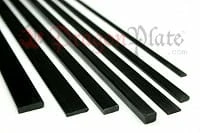How Carbon Fiber is Used in Musical Instruments
Due to its strength, high stiffness to weight, and low damping, carbon fiber has become a sought-after material in various aspects of musical instrument construction, from basic instrument reinforcement to all-out instrument design.

Carbon Fiber Strips for Reinforcement
Carbon fiber strips make it easy to fabricate small, lightweight carbon fiber structures or to provide localized reinforcement because the flat surface provides an ideal surface area for epoxy bonding. This characteristic makes them an ideal choice for a variety of musical instrument applications.
Carbon fiber strips can give the necks of various stringed instruments much greater bending and torsional stability. They can add strength and stiffness to the neck and reduce its weight. In guitars, truss rods can also be combined with carbon fiber strips in various configurations to reinforce necks. The detailed dimensions of the instrument’s neck determine the best orientation for the carbon fiber strips. Along with guitars and mandolins, specialized carbon fiber neck reinforcements have been developed for violins, cellos, and basses, which stabilize the neck and headstock and can even be used as a reinforcement in neck repairs.
Guitar Bracing and Soundboards
Carbon fiber strips are used in conjunction with balsa or spruce as a stiffening laminate to create custom internal guitar bracing. In this case, the low damping, high strength, and high stiffness to weight of the carbon fiber strips provide a real advantage, allowing resonant, lightweight bracing. Further, carbon fiber strips in a lattice formation can make excellent top plate bracing that allows for greater thinning and increased response. Carbon fiber can be placed longitudinally as internal support for the top plate as well.
Soundboards for hollow-body stringed instruments can be fabricated using layers of carbon fiber on a core of wood, paper, foam, or honeycomb. Additional layers can be added to locally increase the stiffness of the soundboard. This process allows the resonance of the instrument to be optimized.
Music Box Passive Amplifiers
Passive amplification using a Helmholtz resonator is useful in a number of applications. For music boxes and singing greeting cards, a small carbon fiber stage has been developed which provides remarkable amplification, particularly in the lower frequency ranges, and adds a nice bass sound to these devices which typically lack lower registers due to their small size. In these situations, the carbon fiber structure transmits sounds exceptionally well.

Carbon Fiber Musical Instruments
While musical purists may object to the idea of stringed instrument constructed of anything but the finest wood, more and more musicians are turning to carbon fiber instruments instead. There are a number of reasons why carbon fiber makes for a more practical concert instrument:
- Weather tolerance: A carbon-fiber instrument can more readily withstand outdoor concerts performed in the heat and humidity of a Gulf Coast summer evening or the cold and damp of a January D.C. inauguration performance. Such weather circumstances strike dread in the hearts of musicians who invested thousands in wood instruments.
- Durability: A musician who travels with their instrument knows the fear of being asked to check it with their baggage. Carbon fiber, with its trademark strength and stiffness, withstands the beating an instrument takes on the road far better than wood instruments.
- Sound: Carbon fiber violins and cellos provide a surprisingly warm sound. They are generally designed in exactly the same way a wood instrument is—using the same shape, chin rests, fingerboards, bridges, sound posts, and so on, as wood designs. The box is simply made of carbon fiber instead of wood. By sticking with traditional construction methods and varying only the material of the instrument box itself, manufacturers are able to create musical instruments with a sound that rivals even the most expensive wood models.
Carbon fiber has long been known as a material well-suited for high-performance applications. Many professional sports personnel, from tennis players to golfers to cyclists, wouldn’t consider a material other than carbon fiber for their equipment these days. Now it is likewise becoming more common for musicians to choose carbon fiber for their instruments as well, whether they are constructing the entire instrument box from carbon fiber or simply creating a stronger instrument using carbon fiber strip reinforcement. As is the case for so many applications, carbon fiber’s characteristics of strength, durability, and low weight make it an ideal choice for musical instrument construction.